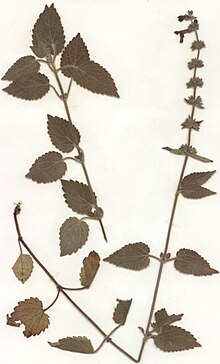Forest Ziest
| Forest Ziest | ||||||||||||
|---|---|---|---|---|---|---|---|---|---|---|---|---|

Forest ziest ( Stachys sylvatica ) |
||||||||||||
| Systematics | ||||||||||||
|
||||||||||||
| Scientific name | ||||||||||||
| Stachys sylvatica | ||||||||||||
| L. |
The Hedge Woundwort ( Stachys sylvatica ) is a species of the genus of Stachys ( Stachys ) in the family of the mint (Lamiaceae).
description
Vegetative characteristics
The forest ziest is a perennial herbaceous plant that reaches heights of between 30 and 120 cm. The flower smells pleasantly lilac-like in the pile, otherwise all parts of the plant smell unpleasant when you rub them. The branched stem is erect or slightly curved and glandular hairy on the four edges.
The opposite leaves are divided into a petiole and a leaf blade, hairy protruding and a bright, strong green. The thin petiole is 3 to 6.5 cm long. The broad and deeply heart-shaped leaf blade is 8 to 12 cm long and 5 to 9.5 cm wide. The leaf margins are serrated.
Generative characteristics
The flowers are in 10 to 20 cm- old inflorescences , usually six (fourth to tenth) in pseudo whorls grouped between foliage-like bracts, which become smaller and smaller towards the top. There are at most tiny cover sheets. The flower stalks are about 1 mm long. The flowers are usually dark red or wine red, in any case almost always clearly darker than the similar marsh ziest . However, purple or pink color variants also occur. There is usually a striking white mark on the lower lip. The flowering period extends from June to September.
The Klausen fruits are smooth, egg-shaped and dark brown.
The number of chromosomes is 2n = 48 or 66.

ecology
The forest ziest is a stem plant with bulbous roots.
The flowers are pre- male hybrid flowers . Pollinators are relatives of bees and hoverflies . Spontaneous self-pollination is performed by itself that the scars branches before fading to the anthers stoop and touching it. Earth bumblebees cause blooms to collapse . The flowering period extends from June to September.
The Klausen fruits are animal and wind spreaders. The fruit ripens from August and lasts until the onset of winter.
Occurrence
The forest ziest is common in temperate and cooler Europe and Asia to the Himalayas and is also found in Macaronesia .
The forest ziest prefers to grow in nutrient-rich and moist places in forests, especially in mixed deciduous forests on Mull . But you can also find it on the edges of the forest or away from the forest in bushes or on shady roadsides. It is a character species of the Alno-Ulmion association, but also occurs in societies of damp Fagetalia forests or in societies of the Alliarion, Aegopodion podagrariae or Atropion associations.
Others
In the forest ziest, deformities of the flowers, especially greening, are not uncommon. Often this happens through an infestation of parasites. There are also forms with a whitish to yellowish crown, which probably represent anthocyanin-free individuals. The variety Stachys sylvatica var. Tomentosa should be mentioned as a further deviation . This is characterized by a dense, yellowish, felty hair on the upper parts of the rung. In many cases, the leaves are significantly smaller than in the typical shape. This variety is known from Bavaria and Austria ( Styria ).
literature
- Xi-wen Li & Ian C. Hedge: Lamiaceae in the Flora of China , Volume 17, 1994, p. 179: Stachys sylvatica - Online. (Section description)
- Henning Haeupler , Thomas Muer: picture atlas of the fern and flowering plants of Germany (= the fern and flowering plants of Germany. Volume 2). Published by the Federal Agency for Nature Conservation. Ulmer, Stuttgart 2000, ISBN 3-8001-3364-4 .
- Wolfgang Adler, Karl Oswald, Raimund Fischer: Excursion flora of Austria. Ed .: Manfred A. Fischer . Ulmer, Stuttgart / Vienna 1994, ISBN 3-8001-3461-6 .
- August Binz , Christian Heitz: School and excursion flora for Switzerland , Schwabe & Co. AG, Basel, 1986, ISBN 3-7965-0832-4
- Erich Oberdorfer : Plant-sociological excursion flora , Ulmer Verlag, Stuttgart, 1990, ISBN 3-8001-3454-3
- Christian August Friedrich Garcke : Illustrierte Flora , 1972, Paul Parey publishing house, ISBN 3-489-68034-0
- Ruprecht Düll , Herfried Kutzelnigg : Pocket dictionary of plants in Germany and neighboring countries. The most common Central European species in portrait. 7th, corrected and enlarged edition. Quelle & Meyer, Wiebelsheim 2011, ISBN 978-3-494-01424-1 .
Individual evidence
- ↑ a b Erich Oberdorfer : Plant-sociological excursion flora for Germany and neighboring areas . With the collaboration of Angelika Schwabe and Theo Müller. 8th, heavily revised and expanded edition. Eugen Ulmer, Stuttgart (Hohenheim) 2001, ISBN 3-8001-3131-5 , pp. 807 .
- ↑ Rafaël Govaerts (ed.): Stachys sylvatica. In: World Checklist of Selected Plant Families (WCSP) - The Board of Trustees of the Royal Botanic Gardens, Kew . Retrieved February 20, 2016.
Web links
- Forest Ziest. In: FloraWeb.de.
- Forest Ziest . In: BiolFlor, the database of biological-ecological characteristics of the flora of Germany.
- Stachys sylvatica L. In: Info Flora , the national data and information center for Swiss flora . Retrieved February 20, 2016.
- Distribution in the northern hemisphere
- Thomas Meyer: Ziest data sheet with identification key and photos at Flora-de: Flora von Deutschland (old name of the website: Flowers in Swabia )
